
Stachys is a genus of plants, one of the largest in the mint family Lamiaceae. Estimates of the number of species vary from about 300, to about 450. Stachys is in the subfamily Lamioideae and its type species is Stachys sylvatica. The precise extent of the genus and its relationship to other genera in the subfamily are poorly known.

Agastache is a genus of aromatic flowering herbaceous perennial plants in the family Lamiaceae. It contains 22 species, mainly native to North America, one species native to eastern Asia. The common names of the species are a variety of fairly ambiguous and confusing "hyssops" and "mints"; as a whole the genus is known as giant hyssops or hummingbird mints.

Lamium album, commonly called white nettle or white dead-nettle, is a flowering plant in the family Lamiaceae. It is native throughout Europe and Asia, growing in a variety of habitats from open grassland to woodland, generally on moist, fertile soils.

Physostegia virginiana, the obedient plant, obedience or false dragonhead, is a species of flowering plant in the mint family, Lamiaceae. It is native to North America, where it is distributed from eastern Canada to northern Mexico. Physostegia are known commonly as obedient plants because a flower pushed to one side will often stay in that position. The name “false dragonhead” refers to the dragonheads of the related Dracocephalum, a genus to which the plant once belonged.
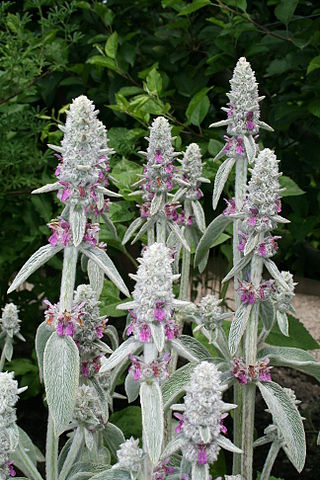
Stachys byzantina, the lamb's-ear or woolly hedgenettle, is a species of flowering plant in the mint family Lamiaceae, native to Armenia, Iran, and Turkey. It is cultivated over much of the temperate world as an ornamental plant, and is naturalised in some locations as an escapee from gardens. Plants are very often found under the synonym Stachys lanata or Stachys olympica.

Stachys coccinea, the scarlet hedgenettle or Texas betony, is an ornamental plant of the family Lamiaceae, which is native from Arizona to Texas and from Baja California Sur, Mexico to Nicaragua.
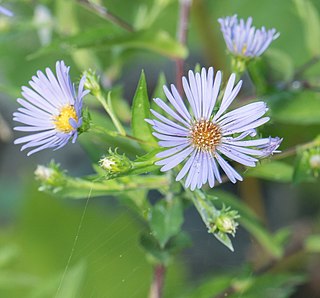
Symphyotrichum puniceum, is a species of flowering plant in the family Asteraceae native to eastern North America. It is commonly known as purplestem aster, red-stalk aster, red-stemmed aster, red-stem aster, and swamp aster. It also has been called early purple aster, cocash, swanweed, and meadow scabish.

Betonica officinalis, commonly known as common hedgenettle, betony, purple betony, wood betony, bishopwort, or bishop's wort, is a species of flowering plant in the mint family Lamiaceae, native to Europe, western Asia, and northern Africa.

Senecio ampullaceus, also known as Texas ragwort, Texas squaw-weed, Texas groundsel, and Texas butterweed, is a species of Senecio in the family Asteraceae, receiving its Latin name ampullaceus from its flask shaped flower-head. It is recommended for landscape use in its native Texas.
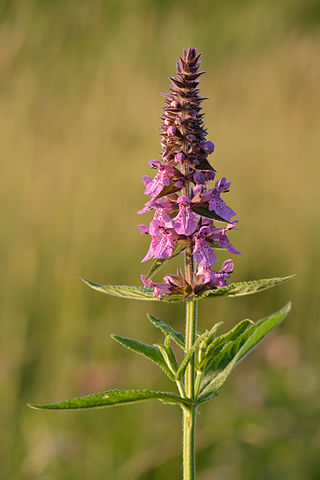
Stachys palustris, commonly known as marsh woundwort, clown's woundwort, clown's heal-all, marsh hedgenettle, or hedge-nettle, is an edible perennial grassland herb growing to 80 centimeters tall. It is native to parts of Eurasia but has been introduced to North America. The species epithet palustris is Latin for "of the marsh" and indicates its common habitat.
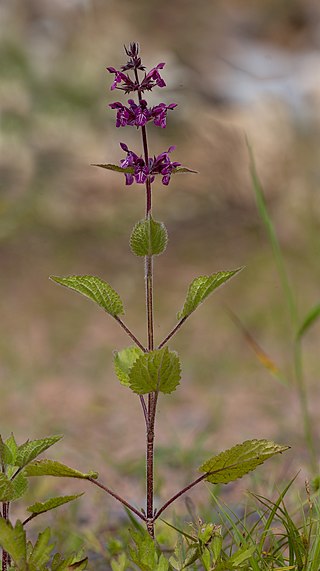
Stachys sylvatica, commonly known as hedge woundwort, whitespot, or sometimes as hedge nettle, is a perennial herbaceous plant growing to 80 cm (31 in) tall in woodland and unmanaged grassland. In temperate zones of the northern hemisphere it flowers in July and August. The flowers are purple. The leaves, when crushed or bruised, give off an unpleasant fetid smell.

Liatris cylindracea is a plant species in the family Asteraceae. It is native to eastern North America, where its populations are concentrated in the Midwestern United States. It is found in habitats such as prairies, limestone and sandstone outcroppings, bluffs, barrens, glades, woodlands and dunes.

Galeopsis bifida is an annual plant native to Europe and Asia but now found in Canada and the northeastern, midwestern parts of the United States. It has many common names such as bifid hemp-nettle, split-lip hemp-nettle, common hemp-nettle, and large-flowered hemp-nettle. The genus name means weasel-like, referring to the corolla of the flower. It is often confused with other species of Lamiaceae such as Mentha arvensis, Dracocephalum parviflorum and Stachys pilosa.
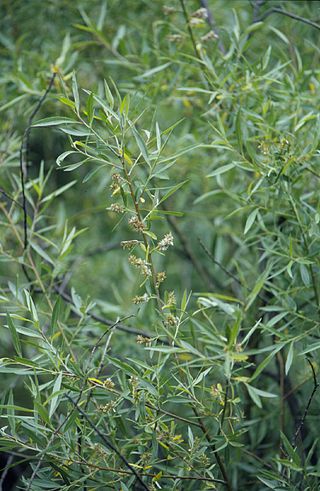
Salix geyeriana is a species of willow known by the common names Geyer's willow, Geyer willow and silver willow. The type specimen was collected by the botanist Karl Andreas Geyer, for whom it was named. Its conspicuous, yellow flowers begin to bloom as early as March, to as late as the end of June.

Coleophora lineolea is a moth of the family Coleophoridae. It is found in most of Europe.

Stachys clingmanii, or Clingman's hedgenettle, is a North American species of plant in the mint family. It is found at higher elevations in the Great Smoky Mountains of Tennessee and the Carolinas, with additional populations in Illinois, Indiana, and Vermont. It is a threatened species in Tennessee.

Gratiola quartermaniae, commonly known as the limestone hedge-hyssop, is a species of flowering plant in the plantain family. It is native to eastern North America.

Ammoselinum butleria, commonly called the Butler's sandparsley, is a species of flowering plant in the carrot family (Apiaceae). It is native to North America, where it is found primarily in the South Central United States. It is most often found in disturbed sandy areas, including lawns. Its range has expanded eastward in recent times, leading some authorities to consider populations east of the Mississippi River to be non-native.
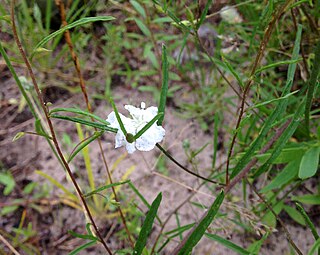
Stylisma pickeringii, commonly called Pickering's dawnflower, is a species of flowering plant in the morning glory family (Convolvulaceae). It is native to the United States, where it patchily distributed across central and eastern regions. Its natural habitat is in dry sandhill prairies. It is apparently tolerant of ecologically disturbed conditions, and can persist in degraded former sand prairies.
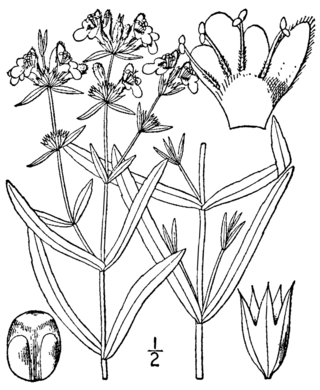
Stachys hyssopifolia, commonly known as hyssop-leaf hedge-nettle, rough hedge-nettlehyssop-leaved hedgenettle, and hyssop hedge-nettle is a species of flowering plant in the mint family (Lamiaceae).



















